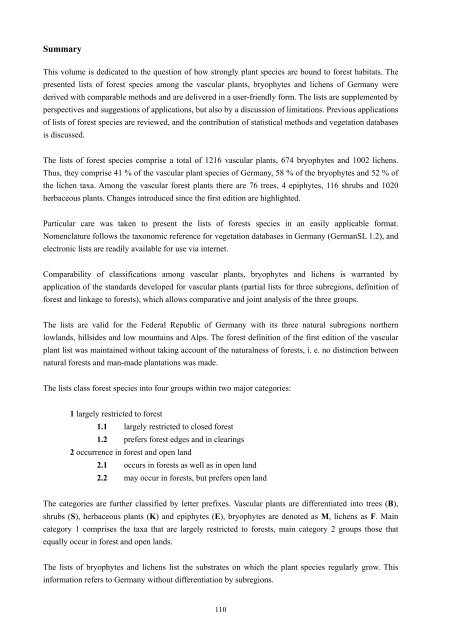Waldartenlisten der Farn- und Blütenpflanzen, Moose und Flechten ...
Waldartenlisten der Farn- und Blütenpflanzen, Moose und Flechten ...
Waldartenlisten der Farn- und Blütenpflanzen, Moose und Flechten ...
Sie wollen auch ein ePaper? Erhöhen Sie die Reichweite Ihrer Titel.
YUMPU macht aus Druck-PDFs automatisch weboptimierte ePaper, die Google liebt.
Summary<br />
This volume is dedicated to the question of how strongly plant species are bo<strong>und</strong> to forest habitats. The<br />
presented lists of forest species among the vascular plants, bryophytes and lichens of Germany were<br />
<strong>der</strong>ived with comparable methods and are delivered in a user-friendly form. The lists are supplemented by<br />
perspectives and suggestions of applications, but also by a discussion of limitations. Previous applications<br />
of lists of forest species are reviewed, and the contribution of statistical methods and vegetation databases<br />
is discussed.<br />
The lists of forest species comprise a total of 1216 vascular plants, 674 bryophytes and 1002 lichens.<br />
Thus, they comprise 41 % of the vascular plant species of Germany, 58 % of the bryophytes and 52 % of<br />
the lichen taxa. Among the vascular forest plants there are 76 trees, 4 epiphytes, 116 shrubs and 1020<br />
herbaceous plants. Changes introduced since the first edition are highlighted.<br />
Particular care was taken to present the lists of forests species in an easily applicable format.<br />
Nomenclature follows the taxonomic reference for vegetation databases in Germany (GermanSL 1.2), and<br />
electronic lists are readily available for use via internet.<br />
Comparability of classifications among vascular plants, bryophytes and lichens is warranted by<br />
application of the standards developed for vascular plants (partial lists for three subregions, definition of<br />
forest and linkage to forests), which allows comparative and joint analysis of the three groups.<br />
The lists are valid for the Fe<strong>der</strong>al Republic of Germany with its three natural subregions northern<br />
lowlands, hillsides and low mountains and Alps. The forest definition of the first edition of the vascular<br />
plant list was maintained without taking account of the naturalness of forests, i. e. no distinction between<br />
natural forests and man-made plantations was made.<br />
The lists class forest species into four groups within two major categories:<br />
1 largely restricted to forest<br />
1.1 largely restricted to closed forest<br />
1.2 prefers forest edges and in clearings<br />
2 occurrence in forest and open land<br />
2.1 occurs in forests as well as in open land<br />
2.2 may occur in forests, but prefers open land<br />
The categories are further classified by letter prefixes. Vascular plants are differentiated into trees (B),<br />
shrubs (S), herbaceous plants (K) and epiphytes (E), bryophytes are denoted as M, lichens as F. Main<br />
category 1 comprises the taxa that are largely restricted to forests, main category 2 groups those that<br />
equally occur in forest and open lands.<br />
The lists of bryophytes and lichens list the substrates on which the plant species regularly grow. This<br />
information refers to Germany without differentiation by subregions.<br />
110

















